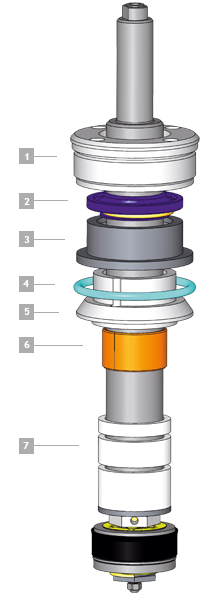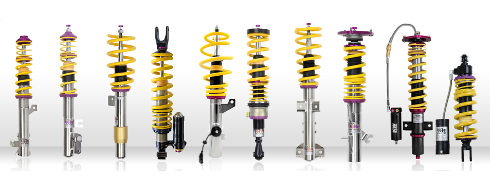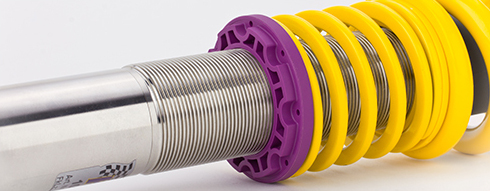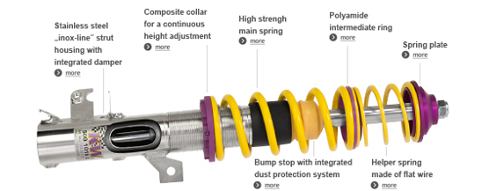
KW Damping and Valve Technology, 2-Way
KW's adjustable damping technology is offered for a wide selection of applications and vehicle categories.
Damper Basics - The Function of a Shock Absorber
The primary job of a shock absorber is to subside vibrations caused by the wheels, axles, and body. The technically correct name for it would be a vibration damper. When driving over irregularities, the force generated or vibrations that are created should be absorbed by the suspension. A proper working damper should prevent the following:
- Excessive body motion or roll during bumps or irregularities
- Nose lifting and diving during acceleration or braking
- Wheel bouncing or losing contact with the ground
- Loss of stability or traction during braking
- Loss of control in turns because of low traction
The shock absorbers used in vehicles are usually twin-tube dampers or mono-tube dampers. A piston moves in an oil-filled cylinder in both damper types. The piston forces the oil through the valves, which creates resistance to the oil flow with the help of various holes and orifices.
During rebound, the oil flows from the outer tube back into the inner tube. In addition to the channels in the bottom valve, the oil also has to flow through the rebound valve located at the piston rod, to get into the piston housing.
How a KW Twin-Tube Shock Absorber Functions
When the cars damper reacts while driving, the oil, which is under minimal pressure, will be displaced by the immersion of the piston rod. The oil then flows into the outer tube through the bottom valve (compression valve) which controls the flow speed. During rebound, the oil flows from the outer tube back into the inner tube. In addition to the channels in the bottom valve, the oil also has to flow through the rebound valve assembly located on the piston rod.
The spring has to absorb and release the stored energy. In a short sequence of these repetitive disruptions, a vibration arises. These movements are transmitted via the piston rod to the shock absorber. Here the kinetic energy is converted to heat by hydraulic resistance in the shock absorber valve and reduces the vibrations to an inaudible minimum.
Rebound Adjustment
Independently adjustable rebound damping

Rebound adjustment with an allen key

Rebound adjustment with the KW adjustment knob, when space allows

Rebound adjustment with an integrated adjustment dial
16 Clicks - Best Perfomance and easy Adjustment
All KW coilover kits that utilize KW's TVR-A (Twin Valve Rebound - Adjustable) technology which provides 16 clicks of independent rebound adjustment.
Rebound adjustments can be made to reflect more dynamic driving characteristics or complement a change in tire selection like a different set of wheels or winter tires.
The adjustable rebound feature allows the user to dial in a more sportier tighter handling characteristic or a more compliant comfortable setting.
Technical details of adjustable rebound damping

Oil flow during high rebound setting

Bypass orifice with high rebound force position. Digressive damping characteristic and the maximum achievable rebound damping. Damping is determined by the setup specific preload of the valve spring in the piston.
The result:
A firm but not a hard rebound stroke, more resistant to rolling and pitching motions.
Oil flow during low rebound setting
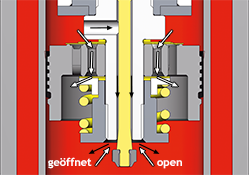
Bypass orifice with open adjuster position allowing for a progressive damping characteristic and ability to achieve minimum possible rebound damping .The bypass oil volume (black arrows) is reduced for the spring preloaded valve on the piston and the damping forces are therefore reduced.
The result:
A lower rebound damping increases the driving comfort.

Graphic representation of the relation from damper speed (m/s) to damping force (N) when adjusting the rebound damping.
Compression Adjustment
Independently adjustable compression damping

Compression adjustment with an
allen key

Compression with a pin wheel adjuster, accessible through an adjustment window
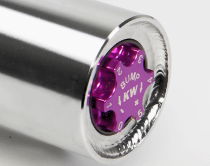
Compression adjustment by use of a integrated adjustment wheel placed at the bottom of the damper

Compression adjustment by an integrated adjustment wheel
12-way adjustable compression damping with a distinct and tactile click.
The KW Variant 3 and KW 2-Way Clubsport coilovers feature KW's TVC-A (Twin Valve Compression - Adjustable) technology and are the ideal system for performance orientated driving enthusiasts who value an a wide range of damping adjustments for their vehicles.
The independently adjustable rebound and compression damping provides an extensive range of damper tuning. This enables the enthusiast to directly effect the turn-in characteristics, stability, tire grip, and handling at the vehicle's limits.
The patented KW valve technology for independent rebound(TVR-A) and compression (TVC-A) damping allows the user to customize their KW damper setup.
Technology of Compression Damping in Detail
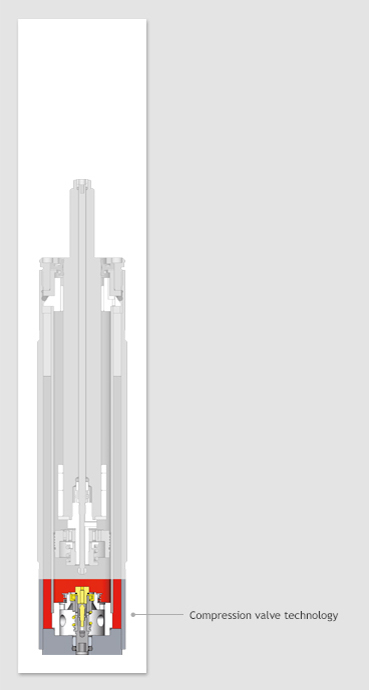
Graphic representation of the relation from damper speed (m/s) to damping force (N) when adjusting the compression damping.

Oil flow during high compression setting
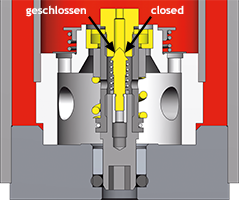

Figure 1:
Spring preloaded needle valve in high compression setting before compression stroke begins
Figure 2:
Position of the needle valve with increasing piston rod velocity
During low piston rod velocity (black arrows), oil is flowing over the spring loaded needle valve
The high speed compression damping (white arrows) is generated by the spring preloaded sleeve. The closed compression valve generates a progressive characteristic low-speed compression damping graph
The result:
A firmer compression stroke adjustment prevents the vehicle from rolling during cornering
Oil flow during low compression setting
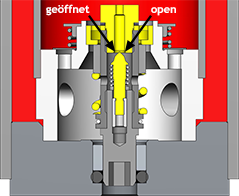

Figure 1:
Spring preloaded needle valve in the compression valve assembly in low compression state before stroke begins
Figure 2:
Position of the needle valve with increasing piston rod velocity
During slower piston rod velocities (black arrows), oil is flowing over the needle valve
The high speed compression damping (white arrows) is generated by the spring preloaded sleeve. The opened bypass valve produces a digressive characteristic compression damping graph in low speed ranges
The result:
The low speed damping of this technology enables a consistent high speed compression damping. The body support of the vehicle during the high speed damping range is not influenced with an opened or closed valve.
KW Piston Rod Guide and Sealing Package
Our modular sealing system exceeds OEM quality standards. It can be easily opened and allows maintenance of the valve technology or rod and piston.
- High tensile aluminum top sealing cap
- Self-lubricated special NBR seal package
- Clamp sleeve
- Temperature-resistant viton O-rings
- Guide bushing with bleed hole
- Special DU Metal-Polymer anti-friction plain bearings
- Polyamide rebound spacers
